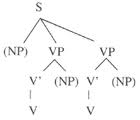Difference between revisions of "SVCs in Mandarin Chinese"
| Line 55: | Line 55: | ||
| − | Based on this classification, the thesis further explores the elements that influence the relationship between V1 and V2 by representing the event structure and argument structure of SVCs. The theoretical supports come from Vendler's (1967)<ref> Vendler, Zeno. 1967. Linguistics in philosophy. Ithaca, New York: Cornell University Press,97-121. </ref> Event Structure Theory, Smith's (1997)<ref> Smith, Carlotas S. 1997. The Parameter of Aspect. Kluwer Acaedmic Publishers. Dordrecht/ Boston/ London. </ref> Aspect Theory ([http://en.wikipedia.org/wiki/Grammatical_aspect Grammatical Aspect] and [http://en.wikipedia.org/wiki/Lexical_aspect Lexical Aspect]) and | + | Based on this classification, the thesis further explores the elements that influence the relationship between V1 and V2 by representing the event structure and argument structure of SVCs. The theoretical supports come from Vendler's (1957, 1967)<ref> Vendler, Zeno. 1957. Verbs and Times. In: The Philosophical Review, Vol. 66, No. 2. (Apr., 1957), pp. 143-160.</ref> <ref> Vendler, Zeno. 1967. Linguistics in philosophy. Ithaca, New York: Cornell University Press,97-121. </ref> and Dowty's (1979)<ref> Dowty, David. 1979. Word meaning and Montague Grammar. Dordrecht, The Netherlands: D. Reidel Publishing Company.</ref> Event Structure Theory, Smith's (1997)<ref> Smith, Carlotas S. 1997. The Parameter of Aspect. Kluwer Acaedmic Publishers. Dordrecht/ Boston/ London. </ref> Aspect Theory ([http://en.wikipedia.org/wiki/Grammatical_aspect Grammatical Aspect] and [http://en.wikipedia.org/wiki/Lexical_aspect Lexical Aspect]) and Smith's and others' [http://www.sfu.ca/person/dearmond/322/322.theta.roles.htm Theta Role Theory] <ref> Fillmore, C. 1968. The case for case, in E. Bach & R. Harms (eds), Universals in linguistic theory, Holt, Rinehart and Winston, New York. </ref> <ref> Jackendoff, Ray. 1990. Semantic structures. Cambridge, Mass.: MIT Press. </ref> <ref> Gruber, J. 1976. Lexical structure in syntax and semantics, North Holland, New York.</ref> |
Revision as of 17:13, 20 June 2012
| Type | Master Thesis |
|---|---|
| Author(s) | Miaomiao Zhang |
| Publisher | NTNU |
| Country | Norway |
| Annotator | Miaomiao Zhang |
| Corpus Link | SVC in Mandarin Chinese |
| Language | English |
Synopsis of Master Thesis
The Master thesis "Serial Verb Constructions in Mandarin Chinese" aims to disambiguate the different definitions and classifications of SVCs in Mandarin Chinese, as well as to explore their semantic properties through investigating the event structures of serial verbs.
Research Methods
This thesis is a data-driven project (using primary and secondary data). Its theoretical focus is to develop a syntactic and semantic taxonomy of serial verb constructions which reflects traditional Chinese approaches and Western approaches alike.
During data collection, secondary data in the form of Interlinear Glossed Texts from the general linguistic literature was stored in TypeCraft and then displayed on a TypeCraft wikipage. The annotated data has been collected on a TypeCraft Category page: Interlinear Glossed Text. All data is freely accessible and can be used for further research. Through clicking the link of the Chinese sentences on the Original Interlinear Glossed Text, one can access a more in-depth annotated version of the data. Re-annotations in order to make already existing data more accessible was part of the author's thesis project. A further part of the author's work is the creation of a small corpus of 118 sentences which can be accessed over the following page: SVC in Mandarin Chinese.
SVCs in Mandarin Chinese
Similar to Complex Predicate (CP) [1] and Multiverb Construction(MVC)[2]], SVC refers to a construction consisting of two or more subject-sharing adjacent verbs or verbal phrases. Hence not only SVCs in different languages, but also SVCs within one language may have different features, and can be further divided into several sub-types.
Following Kröger's (2004)[3] proposal of what is a prototypical SVCs and based on a comparison between the classification of Mandarin SVCs by four Chinese linguists- Chao (1968)[4], Li& Thompson (1989)[5], Lü (2006) [6] and Zhu (1982)[7], the thesis used 118 SVC-examples of the 281 annotated Chinese sentences found in V-V patterns in Mandarin 1, V-V patterns in Mandarin 2, V-V patterns in Mandarin 3and Simon's cat, and the 118 Mandarin SVCs are then divided into 4 sub-groups: Vector SVC, Anchoring SVC, Chaining SVC and Aspectual SVC. These SVC tokens where then sub-divided into several small groups.
Based on this classification, the thesis further explores the elements that influence the relationship between V1 and V2 by representing the event structure and argument structure of SVCs. The theoretical supports come from Vendler's (1957, 1967)[8] [9] and Dowty's (1979)[10] Event Structure Theory, Smith's (1997)[11] Aspect Theory (Grammatical Aspect and Lexical Aspect) and Smith's and others' Theta Role Theory [12] [13] [14]
The analysis of the data on TypeCraft shows that Mandarin SVCs process a rich event and argument structure. Shared subjects may play different thematic roles relative to the serialized verbs. Consider the following two examples:
- SEM: E1-activity E2-achievement
- SYN: V1+V2-give
| sòng |
| sòng |
| sendPRED |
| V1 |
| yībĕn | |
| yī | bĕn |
| one | CL |
| QUANT | |
| shū |
| shū |
| bookOBJTH |
| N |
| gĕi |
| gĕi |
| givePRED |
| V2 |
| tā |
| tā |
| heOBJBEN3SGMASC |
| PN |
- SEM: E1-achievement E2-activity
- SYN: V2-give +V1
| gĕi |
| gĕi |
| givePRED |
| V1 |
| tā |
| tā |
| heOBJBEN3SGMASC |
| PN |
| zhī |
| zhī |
| knitPRED |
| V2 |
| le |
| le |
| PRF |
| PRT |
| yījiàn | |
| yī | jiàn |
| one | CL |
| QUANT | |
| máoyī |
| máoyī |
| sweaterOBJPT |
| N |
References
- ↑ Butt, Miriam. 2003. The light verb jungle. Harvard Working Papers in Linguistics. 9
- ↑ Ameka, Felix K. 2003. Multiverb Constructions in a West African areal typological perspective. Proceedings of TROSS 03. Trondheim, Norway.
- ↑ Kröger, Paul R. 2004. Analyzing Syntax. A Lexical-functional Approach. Cambridge University Press. UK.
- ↑ Chao, Yuenren. 1968. A Grammar of Spoken Chinese. University of California Press. Berkeley and Los Angeles.
- ↑ Li, Charles N. & Thompson, Sandra A.. 1989. Mandarin Chinese: a functional reference grammar. University of California Press. Berkeley, Los Angeles, London.
- ↑ Lü, Shuxiang. 2006. Learning Grammar of Mandarin Chinese (Chinese). Fudan Universitz Press. ISBN: 7309050835. Shanghai, China.
- ↑ Zhu, Dexi. 1982. The Teaching Material for Mandarin Grammar (Chinese). The Commercial Press. Beijing. China.
- ↑ Vendler, Zeno. 1957. Verbs and Times. In: The Philosophical Review, Vol. 66, No. 2. (Apr., 1957), pp. 143-160.
- ↑ Vendler, Zeno. 1967. Linguistics in philosophy. Ithaca, New York: Cornell University Press,97-121.
- ↑ Dowty, David. 1979. Word meaning and Montague Grammar. Dordrecht, The Netherlands: D. Reidel Publishing Company.
- ↑ Smith, Carlotas S. 1997. The Parameter of Aspect. Kluwer Acaedmic Publishers. Dordrecht/ Boston/ London.
- ↑ Fillmore, C. 1968. The case for case, in E. Bach & R. Harms (eds), Universals in linguistic theory, Holt, Rinehart and Winston, New York.
- ↑ Jackendoff, Ray. 1990. Semantic structures. Cambridge, Mass.: MIT Press.
- ↑ Gruber, J. 1976. Lexical structure in syntax and semantics, North Holland, New York.


